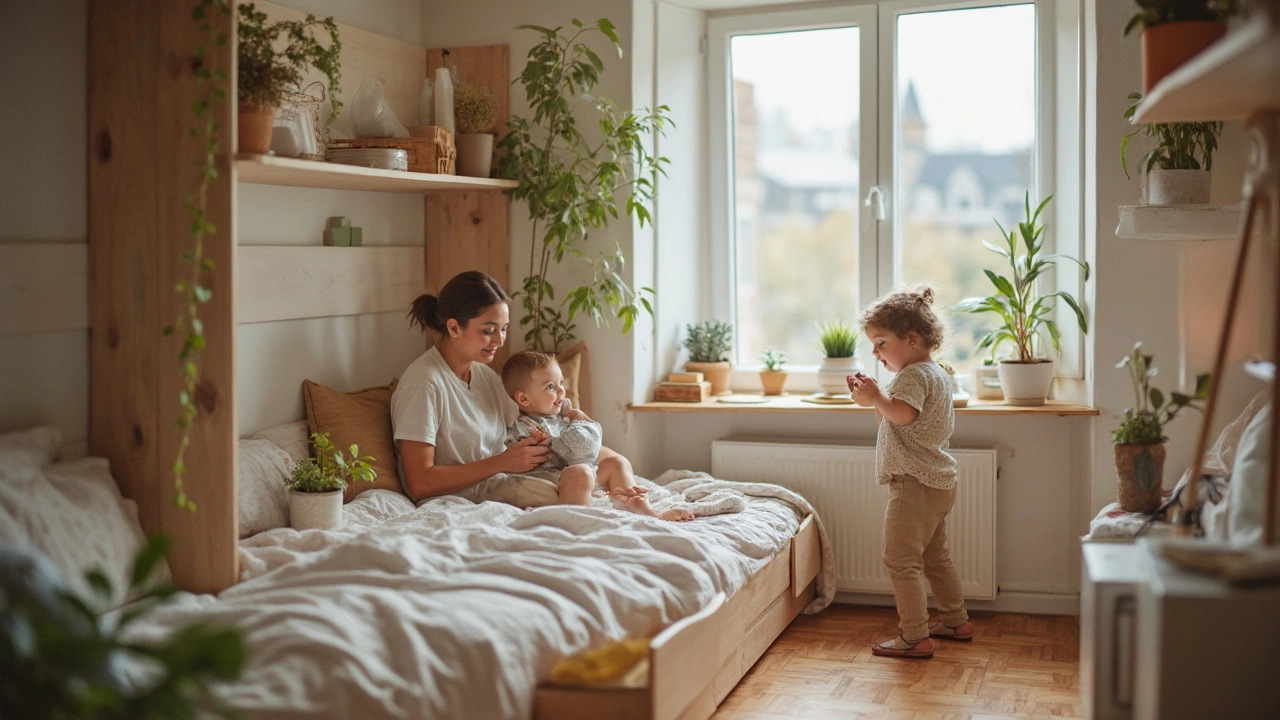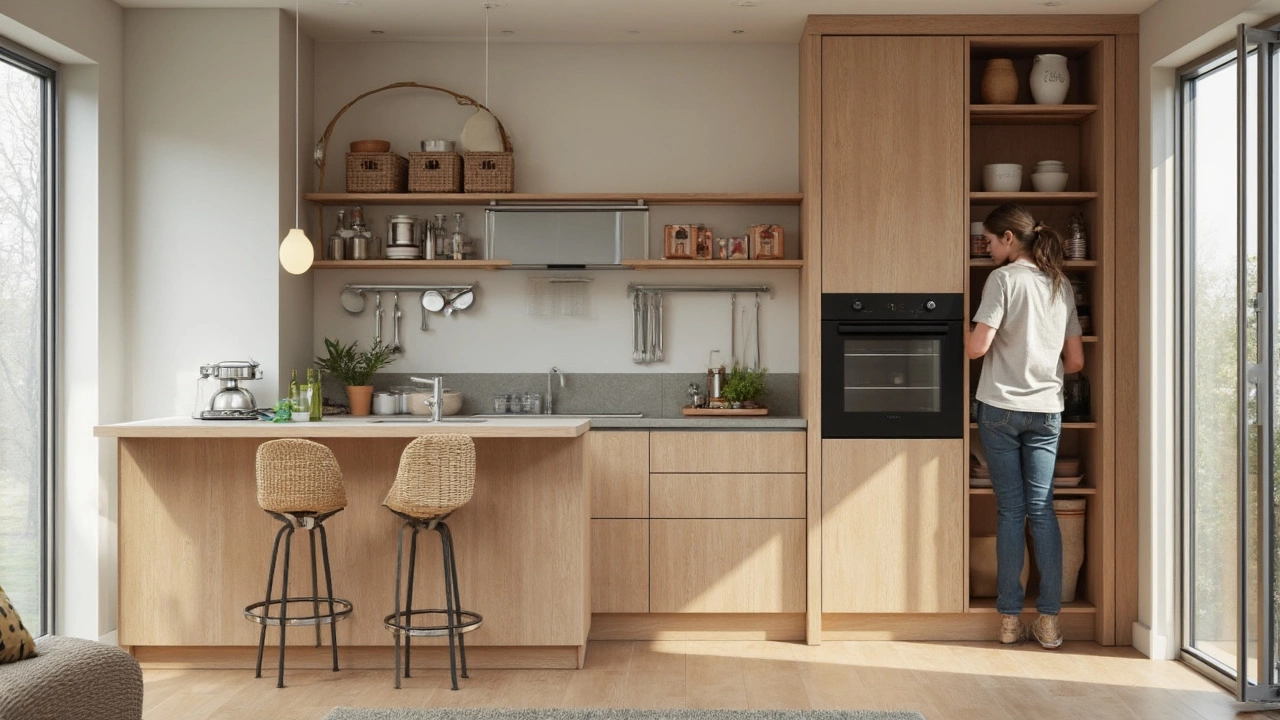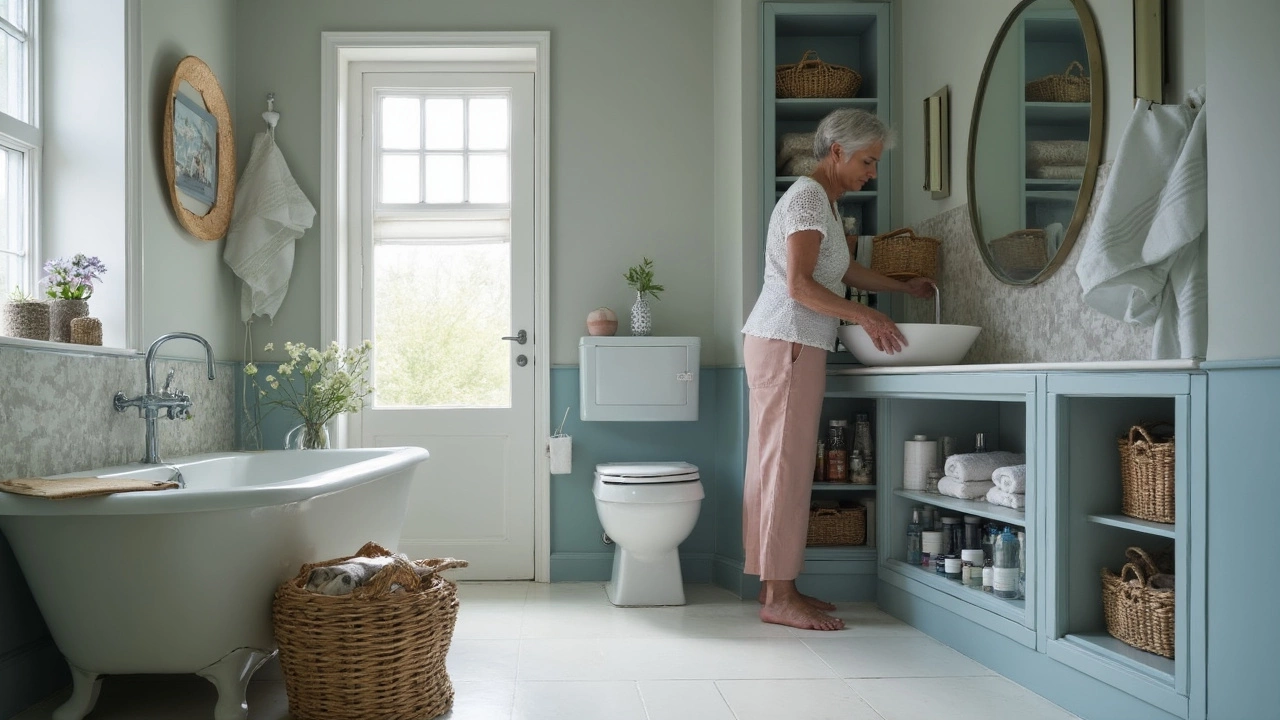Small House Storage: How Do You Organize a Home With No Space?
 Jun, 8 2025
Jun, 8 2025
Ever opened your closet and felt like a game of Tetris just exploded all over your floor? Small houses leave no room for “just in case” stuff or those impulse buys that seemed like a good idea. If you’re drowning in clutter and short on actual storage, it’s time for a reset—and no, you don’t need a fancy walk-in or a pro organizer.
Start with the hard truth: you probably own more than you actually use. Everybody does. Get honest about what you need, what you love, and what’s just hanging out for no reason. Grab three boxes or bags: one for keep, one for donate, and one for toss. Be strict. If a pair of shoes hasn’t seen daylight in a year, it’s dragging you down. Same goes for knick-knacks, never-used kitchen gadgets, and the mysterious wires in your tech drawer.
Every inch in a small house counts double. Learn to think of your space in layers—what’s on the floor, what’s above, what’s behind the door. If you haven’t used the back of a closet door for hooks or the space over your toilet for a shelf, you’re leaving storage gold on the table. That’s just the start.
- The Magic of Decluttering: Get Ruthless
- Think Vertical: Use Walls and Doors
- Multi-Tasking Furniture and Hidden Storage
- Tiny Kitchen, Big Problems: Streamline and Stack
- Habits and Mindset to Stay Organized
The Magic of Decluttering: Get Ruthless
The biggest block to organizing any tiny space is just having too much stuff. Most people actually use less than 20% of what’s in their homes on a regular basis. That extra 80%? It’s often just taking up space and stressing you out. Don’t trust your gut—there’s research out there. A study from UCLA’s Center on Everyday Lives of Families showed a direct link between excess household clutter and higher stress, especially in smaller homes.
Don’t just tidy, declutter for real. Here’s a simple method anyone can follow:
- Pick one small area—like a kitchen drawer or your bathroom cabinet.
- Empty it completely. Don’t cheat and leave stuff behind.
- Sort everything into three groups: keep, donate, or toss. If you haven’t used it in the last year, question why you still own it.
- Right after sorting, take donation bags straight to the car or put trash out—don’t leave it sitting around or you’ll just step over it for weeks.
- Put only the ‘keep’ items back, organizing like-items together.
Looking for some motivation? Check out this quick data table with some eye-openers about what the average household keeps versus uses:
| Category | Average Items Owned | Average Items Used Regularly |
|---|---|---|
| Clothing | 120 | 33 |
| Kitchen Gadgets | 40 | 10 |
| Books | 100 | 15 |
Remember, every item you hang onto in a small house storage situation needs to earn its space. If it’s not useful, not loved, or not used, let it go. Decluttering isn’t just about getting rid of stuff—it’s about keeping your sanity and making your small home feel livable again.
Think Vertical: Use Walls and Doors
Feel like you're out of floor space? Time to look up. Walls and doors are often ignored, but they can double your storage if you use them right. Ditch the idea that shelves are only for books. Use those empty spots for everyday items. As of 2023, a survey by The Association of Home Storage shows that only 32% of folks actually use wall space above head height in their homes. If you’re part of the 68% leaving those gaps empty, you’re missing out on prime real estate.
Let’s get practical. Start with walls in the hallway, kitchen, bathroom, and bedroom. Add shelves above doors, beds, or over windows for things you don’t use daily. Install hooks for bags, hats, keys, or even your favorite frying pan. Pegboards are super popular in tight kitchens because you can move things around as you need.
- Over-the-door organizers are great for shoes, snacks, or cleaning supplies—seriously, put one inside your pantry or under the bathroom sink.
- Magnetic strips work for knives in the kitchen, tools in the garage, or makeup in the bathroom—saves a ton of drawer space.
- If you rent and can’t drill, try adhesive hooks and tension rods. Most hold 5-15 lbs and won’t destroy the paint.
Here’s a quick look at some wall and door storage ideas—the kind people actually use and rave about:
| Space | Vertical Storage Solution | Estimated Capacity |
|---|---|---|
| Bedroom | Wall-mounted basket or shelf | Up to 20 lbs |
| Kitchen | Pegboard or magnetic strip | 10-12 utensils or tools |
| Bathroom | Over-the-door hooks for towels | 3-5 towels |
| Entryway | Row of hooks for bags, jackets, dog leash | 6-8 items |
These fixes don’t cost a fortune—most people spend under $50 to upgrade a whole wall or door. Aim to keep things you use often at eye-level, and stow seasonal or backup stuff up high. Before you know it, small house storage will feel way less impossible.

Multi-Tasking Furniture and Hidden Storage
When square footage is at a premium, your furniture can’t just sit there doing nothing. Every piece should be pulling double (or triple) duty. This is where things get interesting: small house storage is way easier when you make your furniture work for you.
Think about a simple ottoman. Get one that opens up and you suddenly have a spot for blankets, board games, or off-season shoes. Benches with lift-up seats are classics for entryways. Even beds now come with drawers underneath, perfect for stuffing away everything from winter clothes to extra bedding when you just can’t fit another dresser in the room.
How about coffee tables? Most popular studio apartments swear by versions with flip-tops. You get a workspace for your laptop and a cavity underneath for remotes, chargers, or even snacks you don’t want on display. And don’t overlook the sofa bed. Fold it down for guests, then throw all the bedding into a storage chaise or trunk that doubles as a side table.
Hidden storage can really save you in a small house. Try these ideas:
- Slim storage carts that slide between the fridge and wall—great for canned goods or cleaning supplies.
- Hooks under shelves for things like mugs, scissors, or keys (you’ll never lose them again).
- Over-the-cabinet baskets for extra toiletries in the bathroom or dish soap in the kitchen.
- Floating shelves above door frames or windows—nobody ever checks up there, perfect for books or bins.
Here’s something wild: According to a 2024 report by the National Association of Home Builders, over 40% of people who live in homes under 1,000 square feet use furniture with built-in storage. That’s not just a trend; it’s survival mode.
| Furniture Piece | Typical Storage Use | Ideal Room |
|---|---|---|
| Storage Ottoman | Blankets, games, shoes | Living Room, Bedroom |
| Under-Bed Drawers | Clothing, bedding | Bedroom |
| Flip-Top Coffee Table | Remotes, papers, snacks | Living Room |
| Entryway Bench | Shoes, bags, hats | Entry, Hallway |
| Floating Shelves | Books, bins, small decor | Any room |
Get creative. Look for pieces that hide clutter or double as storage, and the whole house will feel lighter—without actually getting rid of what you need. The trick is no dead space. If it’s hollow, stackable, or hides something, it earns its place in your home.
Tiny Kitchen, Big Problems: Streamline and Stack
Small kitchens are brutal. The countertop space is almost non-existent, cabinets are packed before you even start cooking, and there’s never enough room for that new blender. You don’t have to live like you’re always playing Jenga with cereal boxes. There are ways to make even a tiny kitchen work—and work well.
First, you need to go through every cabinet and drawer. Keep only the tools you use at least once a week. That crepe maker you forgot you owned? It can go. Aim for multitasking items—a sharp chef’s knife covers a dozen gadgets, and a single skillet might be worth thirty specialty pans.
- Hang pots and pans from a ceiling rack if you’ve got the ceiling space. They’re easier to grab, and you just freed up a whole cabinet.
- Stackable shelves double your cabinet’s storage. Foldable or stackable bins let you actually use the back of deep shelves—no more digging for lost Tupperware lids.
- The inside of cabinet doors is prime real estate: stick up a spice rack, towel hook, or measuring cup organizer. You’ll wonder how you ever lived without it.
- Magnetic strips for knives, spice jars, or utensils clear up drawer space and keep counters less crowded. They’re cheap and easy to install.
People don’t realize how much vertical space goes to waste. Pop a shelf over your stove or the fridge for rarely used but needed things, like your slow cooker or that jumbo soup pot. Tall, narrow shelves can fit into awkward corners, holding everything from baking sheets to stackable baskets for fruit and snacks.
Here’s a wild fact: The National Kitchen & Bath Association found that Americans with small kitchens waste up to 30% of their available storage, mostly because they don’t stack or use vertical space. That’s a lot of lost room in your life.
| Storage Fix | Approx. Space Gained |
|---|---|
| Magnetic knife strip | 1-2 sq. ft. drawer space |
| Stackable cabinet shelf | 2-4 sq. ft. shelf space |
| Pan hook rack | One full cabinet |
| Back-of-door rack | Half a drawer |
Missing a pantry? Try a slim rolling cart that fits between the fridge and the wall. Stack canned goods, snacks, or cleaning stuff. Or use clear containers—you’ll see what you have. No more accidental triple buys of pasta because you couldn’t spot the boxes hiding in the back.
Here’s the thing: a small house storage problem always calls for thinking upward, not outward. Be ruthless, be clever, and stacking isn’t just a solution—it’s a survival trick in a small kitchen.

Habits and Mindset to Stay Organized
Tricks and baskets are useless if you keep letting stuff pile up. Getting organized in a small house isn’t a one-time project—it’s a way you live. People with tidy, functional small homes usually have a few routines and ground rules that they stick to like glue.
If you want your home to stop feeling cramped, start changing how you deal with things as soon as they come in the door. Most stuff that clutters up small spaces—mail, bags, laundry—wasn’t part of some big shopping spree. It slips in little by little. Nipping this in the bud makes a difference fast.
- small house storage depends on a "one in, one out" rule: buy something new, get rid of something old. This keeps closets, drawers, and shelves from bursting.
- Make decluttering a habit, not a yearly event. Schedule a quick 10-minute scan once a week—shoes by the door, mail on the table, bathroom counter. You’ll be surprised how much mess this cuts down.
- Everything should have a home. If an item doesn’t fit in your current setup, either find it a spot or reconsider if you need it at all.
- Storage bins and baskets are tempting, but if they’re just hiding junk you never use, they’re another problem. Open bins at eye level work best for things you really use every day.
Here’s the kicker: Researchers at UCLA’s Center on Everyday Lives and Families found that households with even moderate clutter were much more likely to feel stressed—especially when spaces were tiny. People felt less overwhelmed if they had routines for putting things away immediately.
| Household Size | Small Space (<800 sq ft) | Regular Space (>1500 sq ft) |
|---|---|---|
| 1-2 people | 15 | 8 |
| 3-4 people | 22 | 12 |
So yeah, it takes more work in a smaller house. But people who stick to routines say their homes "feel bigger"—and it’s not just chatter. Less clutter actually lets you spread out more and use your space the way you want.
Mindset makes a huge difference, too. Instead of thinking “I need more space,” try flipping it to “I need less stuff.” Change the way you look at storage, and you’ll see possibilities everywhere. A little discipline, some simple habits, and you’ll find your small place has more breathing room than you thought.